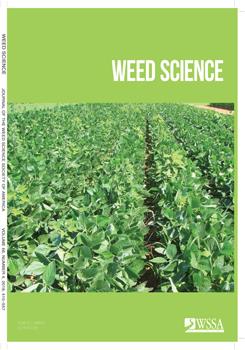Palmer amaranth (Amaranthus palmeri S. Watson) is a problematic weed encountered in U.S. cotton (Gossypium hirsutum L.) and soybean [Glycine max (L.) Merr.] production, with infestations spreading northward. This research investigated the influence of planting date (early, mid-, and late season) and population (AR, IN, MO, MS, NE, and TN) on A. palmeri growth and reproduction at two locations. All populations planted early or midseason at Throckmorton Purdue Agricultural Center (TPAC) and Arkansas Agriculture Research and Extension Center (AAREC) measured 196 and 141 cm or more, respectively. Amaranthus palmeri height did not exceed 168 and 134 cm when planted late season at TPAC and AAREC, respectively. Early season planted A. palmeri from NE grew to 50% of maximum height 8 to 13 d earlier than all other populations under TPAC conditions. In addition, the NE population planted early, mid-, and late season achieved 50% inflorescence emergence 5, 4, and 6 d earlier than all other populations, respectively. All populations established at TPAC produced fewer than 100,000 seeds plant-1. No population planted at TPAC and AAREC produced more than 740 and 1,520 g plant-1 of biomass at 17 and 19 wk after planting, respectively. Planting date influenced the distribution of male and female plants at TPAC, but not at AAREC. Amaranthus palmeri from IN and MS planted late season had male-to-female plant ratios of 1.3:1 and 1.7:1, respectively. Amaranthus palmeri introduced to TPAC from NE can produce up to 7,500 seeds plant-1 if emergence occurs in mid-July. An NE A. palmeri population exhibited biological characteristics allowing it to be highly competitive if introduced to TPAC due to a similar latitudinal range, but was least competitive when introduced to AAREC. Although A. palmeri originating from different locations can vary biologically, plants exhibited environmental plasticity and could complete their life cycle and contribute to spreading populations.
How to translate text using browser tools
1 July 2018
Phenology of Five Palmer amaranth (Amaranthus palmeri) Populations Grown in Northern Indiana and Arkansas
Douglas J. Spaunhorst,
Pratap Devkota,
William G. Johnson,
Reid J. Smeda,
Christopher J. Meyer,
Jason K. Norsworthy
ACCESS THE FULL ARTICLE

Weed Science
Vol. 66 • No. 4
July-August 2018
Vol. 66 • No. 4
July-August 2018
Genetic and environmental variation
geographic range
pigweeds
seed production
weed biology





